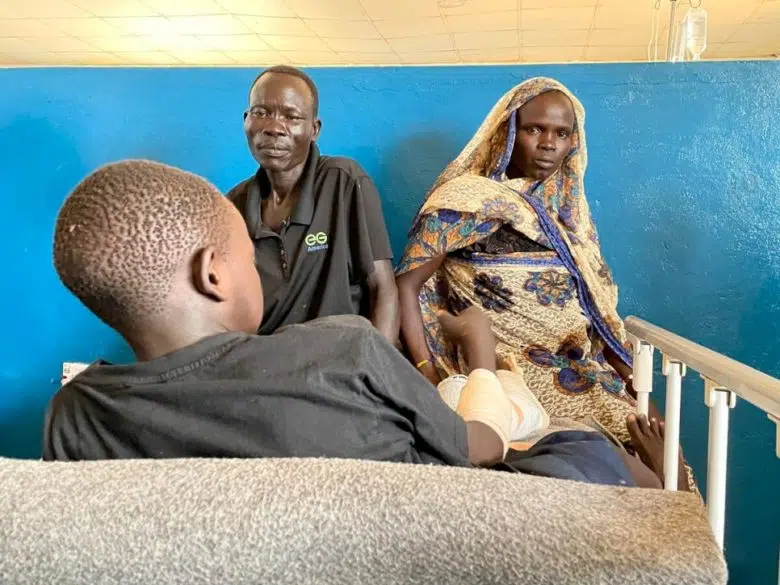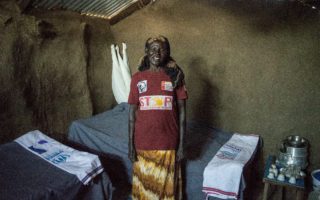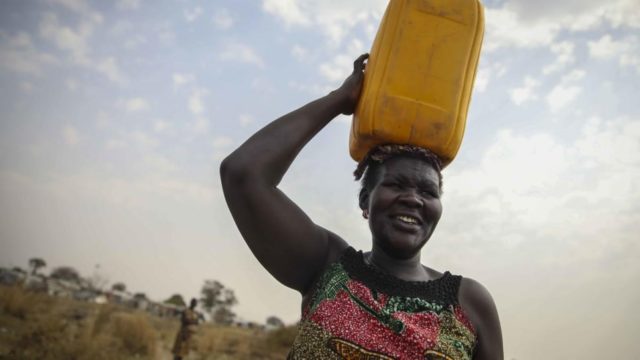
Parents Hissen Awad Mohammed (L) and Haja Ibrahim watch over their injured son Fathihe at Maban County hospital, Bunj, South Sudan. © UNHCR/Tim Gaynor
Pain, anguish and a search for answers as an explosion kills four refugee boys in Maban County, where decades of conflict have left a cache of unexploded ordnance.
By Tim Gaynor and Nour Abdulhak
Bunj, SOUTH SUDAN – Their schoolwork done, the group of boys aged 12 to 14 set out to graze their families’ sheep and goats on land near their homes and were excited by their find.
The metal tube would make a bell to put around the neck of one of their goats, with just a few hammer blows. Setting it down in the shade of a tree, they began.
“They were hitting it hard. There was smoke, a flash,” 12-year-old Fathihe later recalled.
When the 60mm mortar round exploded, friends Babikit, Awuda, Ahmed, and Balla were killed outright.
Shrapnel took off two fingers from Fathihe’s left hand, tore into his right lower leg, and left him with wounds to his right hand and arm.
More than two weeks after the blast he lies in a hospital ward in Bunj, in Maban County in northeast South Sudan, watched over night and day by his father Hissen Awad Mohammed, 38, and his mother Haja Ibrahim, and four sisters.
“He is slowly recovering,” says Hissen, a farmer. The other parents in the tight-knit clan of refugees who fled conflict in Sudan together more than a decade ago have been left devastated.
“I can’t believe that my son is dead.”
South Sudan is one of the poorest and most conflict impacted countries in Africa. Combatants fought for decades in a war leading to independence in 2011, and in sporadic violence since. In some places like Maban, bombs and mines continue to be found, despite ongoing efforts to remove them.
Each afternoon since the blast on 13 May, Hawa Farouk expects her son Balla to return from school to their one-room home where the 14-year-old’s schoolbooks are still tucked under the eaves, and his English homework chalked up on the mud walls.
“I can’t believe that my son is dead. I believe that he is in school, studying. When the kids come back from school, I am waiting for him to come back with them,” she says, her eyes dim with grief.
Hawa remembers her only son as a studious and caring boy who planted an acacia tree in the yard for shade, ran to the shops for supplies, and promised to look after his mother and father when he graduated school.
“If I’m successful in my education, all your worries, all your pains will come to an end. I will support you and you will not suffer any more in life,” Hawa recalls him saying.
Three days after the blast, Balla and his friends were buried in the same grave. Their parents live a few paces apart in mud-walled, straw-roofed homes, ringed by stick and thorn fences. For Yahiya Shanir Adair, the father of football-loving 12-year-old, Ahmed, the loss is hard to bear.
“He was a good boy, always willing to help,” he says, sitting on a rope bed pulled into the shade of a tree in his yard in Maban County, which is home to 176,000 refugees and 70,000 local residents.
“Their deaths have affected not just the community, but the whole of Maban … If the children had graduated school, then the community would have benefitted. Some of them could have been doctors, some of them could have been ministers … it is a huge loss to the community,” Yahiya adds.
The United Nations Mine Action Service, UNMAS, has destroyed 1,091,968 explosive devices in South Sudan. These include 40,121 mines, 76,879 cluster munitions, and 974,968 other items of unexploded ordnance, known as UXO, making facilities like water points and schools safe.
But the recent blast highlights the ongoing challenge of deadly weapons in areas like Maban that have been fought over time and again since the 1980s, and where UXO remain buried in areas where refugees and residents fetch water, graze animals and go about their lives.
“The issue is flooding. Every year we have flooding. When floods come, there is erosion and it uncovers UXO,” says Joseph Guya, an assistant security officer in Maban for UNHCR, the UN Refugee Agency. “The last flood in October last year uncovered a lot of UXO in residential areas,” he adds.
In one incident that Guya attended, a 120 mm mortar round was revealed by erosion beside the fence in a family’s backyard. “The residents just saw it. This happened about four times in Bunj,” he says.
UNHCR is working closely with UNMAS and security firm G4S to ensure that all UXO reported are removed. It also supports an information campaign that began before the recent blast and is ongoing across the country, including in all four refugee camps in Maban.
Talks and a leaflet in English and Arabic seek to raise awareness of the deadly threat from unexploded ordnance, and help refugees, residents and aid workers alike to be able to identify munitions and report them.
UNHCR also works closely with partner Jesuit Refugee Services, which provides ongoing counseling to the bereaved families. In addition, Save the Children International gave aid including food, fuel, clothing and bedding, and has supported Fathihe at Bunj Hospital, together with another injured boy who has since been discharged.
The bereaved families receive visitors and take some consolation from the grief shared. Some – like Yahiya, 58 – have begun spreading awareness of the dangers through extended family networks in the camps. He is clear, though, that more needs to be done to ensure the tragedy does not repeat itself.
“The land needs to be cleared (of UXO) so that children can move, so that refugees can move, so that women can collect firewood,” he says.
And lost in her grief for Balla, Hawa too is adamant: “At night I can’t sleep. We miss him too much. He was like our hope,” she says. “This must never happen again to anyone else in our community.”
Originally published by UNHCR on 09 June 2022.





